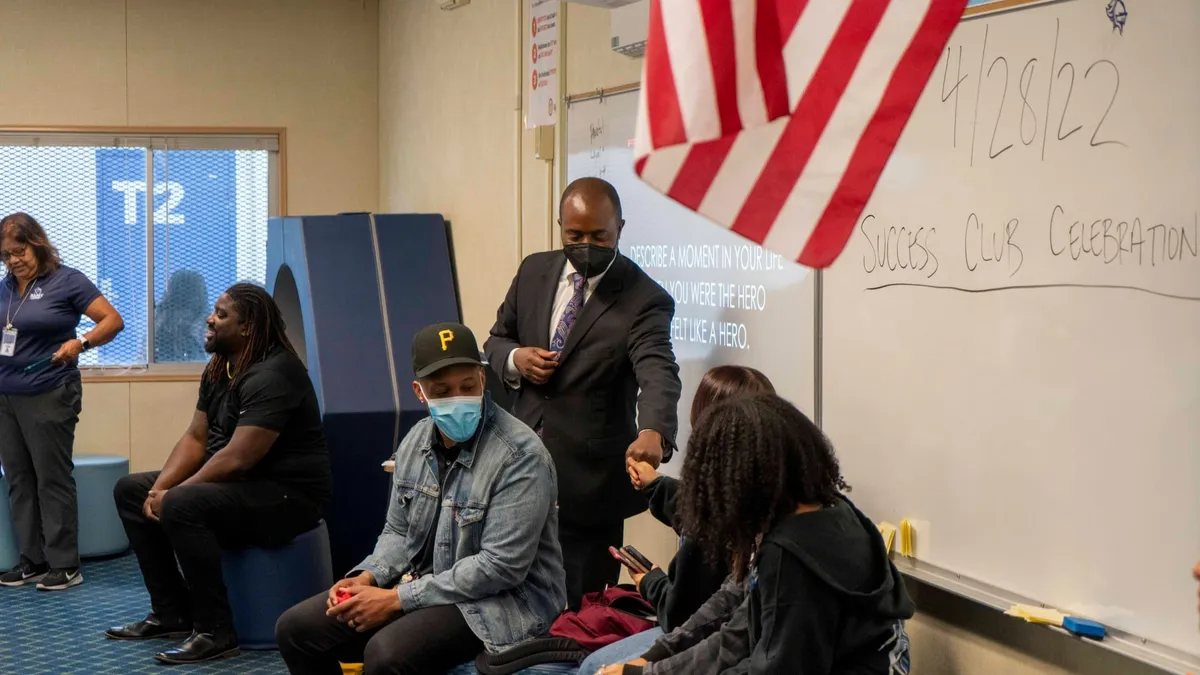Data on early-career teachers, teacher absenteeism and the amount districts spend on specific positions in schools are among the survey questions the U.S. Department of Education’s Office for Civil Rights (OCR) plans to eliminate from the Civil Rights Data Collection (CRDC) for 2019-2020.
As part of the “Paperwork Reduction Act” and in an effort to reduce the reporting "burden" on districts, officials are also proposing to “retire” several data elements related to early-childhood education, such as whether the district is providing full- or part-day preschool, whether those classrooms are located in district or non-district facilities and which children receive preschool services — such as children in low-income families, in Title I schools or with special needs.
Districts would also no longer have to report whether their kindergarten programs are full day and whether they charge any fees for part of the school day for kindergartners. And the number of questions related to preschool suspension would also be reduced. Specifically, the proposal would no longer require districts to disaggregate out-of-school suspensions by demographic subgroups and would combine into one category separate questions on the number of preschoolers who received one suspension and the number who received multiple suspensions.
Ed Department officials did not respond to questions about the proposals from Education Dive prior to publication. The deadline to submit comments on the proposed changes is Nov. 18.
“It is important for ED to deregulate where possible so that limited education funds may be directed to more effectively advance the education of students and LEAs may experience less burden and improve the quality of the data submitted for the CRDC,” according to documents posted last week by the Office of Management and Budget.
But there are also topics where the department plans to ask districts for more information, such as the number of religious-related bullying incidents for the 14 religious categories identified in the FBI’s data collection on hate crimes. Questions on bullying related to religion were optional for the 2015-16 CRDC, but according to the OMB documents, roughly 10,000 of the 135,200 bullying incidents reported in that survey were related to religion.
“Collecting these data could potentially allow [the Office for Civil Rights] to provide technical assistance where there are patterns of conduct, especially where ethnic or ancestral harassment is combined with directed religious discrimination,” according to the documents.
Districts won’t be required to ask for a student’s religion, and the victim doesn’t have to identify with one of the 14 religions. But districts will be expected to “look to the likely motives” of the bullies and whether they perceived a student to ascribe to that religion.
How will data be collected?
Seth Galanter, an education law expert with the National Center for Youth Law — who worked in the OCR under the Obama administration — questioned how districts will collect this data.
“Obviously, religious harassment is bad,” he said. “But OCR doesn't even have jurisdiction over most religious discrimination. And the department offers no explanation how they're expecting school districts to track and report this data without putting kids' religions in their school records.”
Ron Avi Astor, an education and social welfare professor at the University of California Los Angeles — whose work has included research on school violence and bullying — said it would be "good to know if kids of certain religions are getting bullied more or not."
But, Astor said, incidents actually reported by schools are likely to represent only the “tip of the iceberg” of what’s taking place and one’s perceived religion may or may not be the real reason for the bullying.
Finally, he added any data should be considered in the context of student perception surveys on whether or not students believe they were bullied for religious beliefs. He suggested questions could be added to student surveys that allow them to check a specific religion if they felt they were bullied for that reason.
The department also proposes to collect information on the number of rapes, attempted rapes or sexual assaults committed by students and staff members at the school, as well as whether any incidents involving staff members resulted in a termination or retirement.
But the department’s recent agreement requiring an overhaul of how the Chicago Public Schools handles such complaints included a case of teacher-on-student sexual violence that occurred outside of school.
And K-12 leaders have expressed alarm over Education Secretary Betsy DeVos’ proposed Title IX guidelines, saying they “have the potential to increase the likelihood of litigation in districts because they so severely restrict when and how districts can investigate and under what circumstances students can report.”
Proposed workforce data changes
The department proposes to no longer ask districts to report numbers of first- and second-year teachers, but some experts stress such data is important when deciding how to assign and support novice teachers.
“This data does matter,” said Jessica Cardichon, director of federal policy for the Learning Policy Institute (LPI) as well as director of LPI’s Washington office. “We know from research that students of color have less access to experienced teachers.”
A forthcoming report from LPI, reviewing research on the impact of teacher experience on student achievement, will show first- and second-year teachers make up a greater proportion of the teaching staff in schools with high enrollments of students of color. In these schools “nearly one in every six teachers is just beginning his or her career compared to one in every 10 teachers in schools with low enrollment of students of color,” according to the upcoming report.
The data is also important for district leaders in making decisions regarding which schools are in greater need of teacher mentoring and induction programs, Cardichon said. “The less information that you have, that makes it more of a challenge to target the resources,” she said.
Under the proposal, questions on spending related to specific positions in schools, such as teachers, aides and other support personnel, would also be dropped in the next round of data collection.
“They are also going make it impossible to understand how much is spent at each school on various personnel, which is obviously tied to the quality and quantity of services,” Galanter said.
But Marguerite Roza, director of the Edunomics Lab at Georgetown University, said there was a general sense “that the CRDC expenditure questions hadn’t been that successful in yielding reliable data.”
The questions, she added, used definitions of positions that are not standard across districts and called for “some splicing of expenditures in ways that district data systems don’t all splice them.”
The proposal also includes dropping a question on how many teachers were absent for at least 10 days during the school year.
“My first reaction is that some of these are incredibly important data that we really ought to be collecting so that we can understand what's going on in our public schools,” said David Griffith, a senior research and policy associate at the Thomas B. Fordham Institute, whose 2017 report on teacher absenteeism showed 28.3% of teachers in traditional public schools missed at least 10 days of school.
Griffith called teacher absenteeism one of two “well-known diseases that will only spread more quickly in the absence of sunlight.” He’s also argued in favor of using chronic teacher absenteeism data as a measure of school quality over using chronic absenteeism rates among students.
Proposed secondary data changes
The other “disease,” Griffith said, is credit recovery. The department is also proposing to stop collecting data on the number of students in credit recovery programs. But researchers have suggested sufficient data on these programs is already lacking, and schools with higher proportions of poor students and students of color, as well as urban and large high schools, enroll more students in credit recovery classes.
For the 2017-18 CRDC, which won’t be available until next year, OCR dropped questions related to Advanced Placement (AP) exam results. For 2019-20, officials are proposing to stop asking schools for numbers of students who enrolled in AP courses, but ended up not taking the exam.
Galanter said the move “denies the public an understanding of how often obstacles prevent students from taking full advantage of advanced classes offered at the school — they are giving up the chance for college credits.” The College Board is also reviewing the proposed change, said Jaslee Carayol, associate director of media relations.
OCR, however, is proposing to add a data element related to AP and International Baccalaureate (IB) program enrollment, collecting the number students served under Section 504 by sex.
The Trump administration’s actions related to civil rights issues have been controversial from the start. The decision to rescind Obama-era guidance intended to eliminate racial disparities in school discipline was criticized by those who argue students of color receive harsher consequences than white students for the same infractions.
And under DeVos, the department delayed for two years implementation of Obama-era regulations requiring schools to report the demographics of students in special education programs in an effort to identify significant disproportionality. In March, a U.S. District Court judge called the decision to delay “arbitrary and capricious.”
Advocacy groups also challenged the department’s efforts to dismiss multiple OCR complaints from so-called “mass filers,” and last year, the agency went back to investigating individual complaints, including those it dismissed during a nine-month gap.
The department, however, touts its handling of civil rights issues, saying it is resolving complaints “both efficiently and effectively” and at a faster rate than during the previous administration.





















